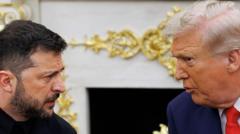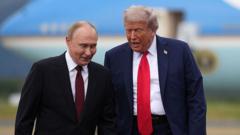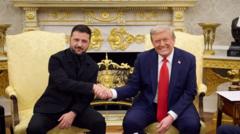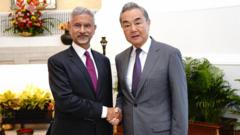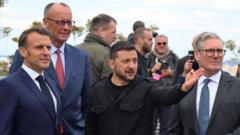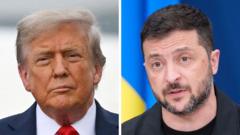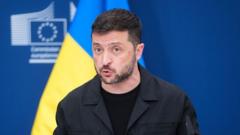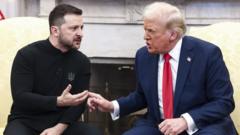The Oval Office's map showing Russian-occupied territories in Ukraine underscores the differing strategies of Donald Trump and Volodymyr Zelensky regarding the ongoing war, complicating dialogue on potential territorial compromises.**
Trump and Zelensky's Diverging Visions Highlighted by Oval Office Map**
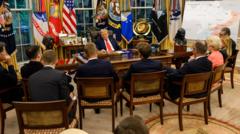
Trump and Zelensky's Diverging Visions Highlighted by Oval Office Map**
A map in the Oval Office reveals stark differences in perspectives on Ukraine's territorial conflict between Trump and Zelensky.**
The map displayed prominently in the Oval Office during President Trump's recent meeting with Ukrainian President Volodymyr Zelensky illustrates a critical disparity in their approaches to the ongoing Ukraine war. This large illustration, which marked various regions in red indicating Russian occupation, was intended to emphasize the vast territories that have been seized since the onset of hostilities. "There's a significant portion that is taken," Trump asserted in a Fox News interview shortly after the meeting, indicating a pressing need for Ukraine to negotiate a potential territorial compromise with Russia.
According to reports, Zelensky arrived equipped with his own representation of Ukraine's territorial integrity and expressed concern over the accuracy of the Oval Office map. His commitment to fighting for every inch was clear as he underscored the stark realities of territorial control during his discussions with Trump. However, Trump's prevailing belief seemed to be that Russia's military capabilities were vastly superior, suggesting Ukraine's reality was rendered bleak.
While discussions around land swaps and ceding territories were floated among Western allies, Zelensky argued passionately against any concessions. Data from the U.S. Institute for the Study of War aligns with the White House's figures, which indicate that Russia currently controls substantial portions of several Ukrainian regions, including over three-quarters of Donetsk in the Donbas area.
The conversation in Washington indicates a sharp contrast in the negotiation strategies of both leaders. Zelensky optimistically pointed out that in the past 1,000 days, Russia has only managed to occupy minimal additional territory, while Trump’s narrative focused on the overwhelming military resources Russia has at its disposal. This disconnect reflects divergent strategies regarding the protraction of the war and underscores the challenge of aligning interests in ongoing diplomatic negotiations.
Experts highlight the renewed Russian momentum in the east, especially around strategic locations like Kupiansk and Kreminna, while simultaneously mentioning that Ukraine still retains significant control over key areas. Reports suggest Russia has bolstered its forces effectively despite significant losses, leading to fears of extended conflict.
This meeting, captured vividly in discussions surrounding territorial integrity, illustrates the complexities of peace negotiations and the contrasting perspectives that impede unified support for Ukrainian sovereignty. As the map remains a symbol of both opportunity and division, Zelensky nevertheless expressed appreciation for the gesture, acknowledging the necessity of navigating difficult discussions as Ukraine seeks to reclaim lost territories.

